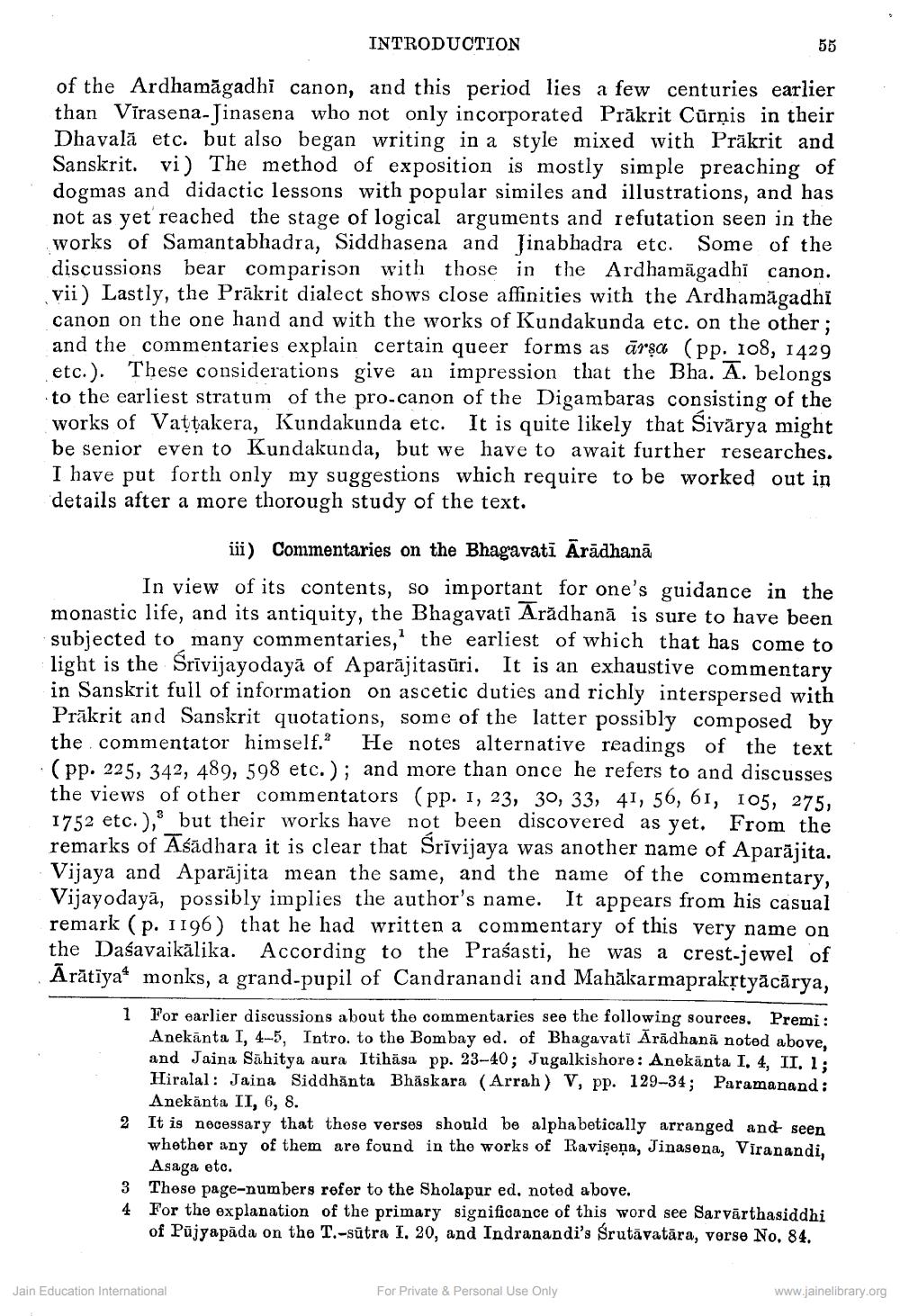________________
INTRODUCTION
of the Ardhamăgadhi canon, and this period lies a few centuries earlier than Virasena-Jinasena who not only incorporated Prākrit Cūrnis in their Dhavală etc. but also began writing in a style mixed with Prākrit and Sanskrit. vi) The method of exposition is mostly simple preaching of dogmas and didactic lessons with popular similes and illustrations, and has not as yet reached the stage of logical arguments and refutation seen in the works of Samantabhadra, Siddhasena and Jinabhadra etc. Some of the discussions bear comparison with those in the Ardhamāgadhi canon. vii) Lastly, the Prākrit dialect shows close affinities with the Ardhamāgadhi canon on the one hand and with the works of Kundakunda etc. on the other; and the commentaries explain certain queer forms as ārsa (pp. 108, 1429 etc.). These considerations give an impression that the Bha. A. belongs to the earliest stratum of the pro-canon of the Digambaras consisting of the works of Vattakera, Kundakunda etc. It is quite likely that Sivärya might be senior even to Kundakunda, but we have to await further researches. I have put forth only my suggestions which require to be worked out in details after a more thorough study of the text.
iii) Commentaries on the Bhagavati Ārādhanā In view of its contents, so important for one's guidance in the monastic life, and its antiquity, the Bhagavati Aradhanā is sure to have been subjected to many commentaries, the earliest of which that has come to light is the Srīvijayodaya of Aparājitasūri. It is an exhaustive commentary in Sanskrit full of information on ascetic duties and richly interspersed with Prākrit and Sanskrit quotations, some of the latter possibly composed by the commentator himself. He notes alternative readings of the text (pp. 225, 342, 489, 598 etc.); and more than once he refers to and discusses the views of other commentators (pp. 1, 23, 30, 33, 41, 56, 61, 105, 275, 1752 etc.), but their works have not been discovered as yet. From the remarks of Asādhara it is clear that Srivijaya was another name of Aparajita. Vijaya and Aparājita mean the same, and the name of the commentary, Vijayodayā, possibly implies the author's name. It appears from his casual remark (p. 1196) that he had written a commentary of this very name on the Daśavaikälika. According to the Praśasti, he was a crest-jewel of Arātiya* monks, a grand-pupil of Candranandi and Mahākarmaprakstyācārya,
1 For earlier discussions about the commentaries see the following sources. Premi:
Anekānta I, 4-5, Intro. to the Bombay ed. of Bhagavati Arādhanā noted above, and Jaina Sahitya aura Itihāsa pp. 23-40; Jugalkishore: Anekānta I. 4, II. 1; Hiralal: Jaina Siddhanta Bhaskara (Arrah) V, PP. 129-34; Paramanand :
Anekänta II, 6, 8. 2 It is necessary that these verses should be alphabetically arranged and seen
whether any of them are found in the works of Ravişeņa, Jinasena, Viranandi,
Asaga etc. 3 These page-numbers refer to the Sholapur ed, noted above. 4 For the explanation of the primary significance of this word see Sarvārthasiddhi
of Pūjyapāda on the T.-sūtra I. 20, and Indranandi's Śrutāvatāra, verse No. 84.
Jain Education International
For Private & Personal Use Only
www.jainelibrary.org




